It has been something of an article of faith that in the 11th century,
particularly at the Battle of Hastings, coifs, the hoods of mail armour worn under the helmet, were integral with the byrnie (mail shirt)
rather than separate from it. However, it is by no means clear that this was the
case. Though there are many figures in the Bayeux Tapestry without any
demarcation between hauberk and coif, there are enough that do to make me
fairly suspicious of any blanket statements.
If you want to
investigate the Tapestry in detail, have a look at http://www.hastings1066.com/
or get one of the books available in any good library (usually called The
Bayeux Tapestry and sometimes held under the "Needlework"
section, for heaven's sake!), which contain the complete Tapestry frame by
frame. One particularly good one (though I disagree with its conclusion that
the Tapestry was produced in Normandy rather than England) is The Bayeux
Tapestry: Monument to a Norman Triumph by Wolfgang Grape; Prestel, Munich
and New York, publishing date unknown but some time in the 1990’s.
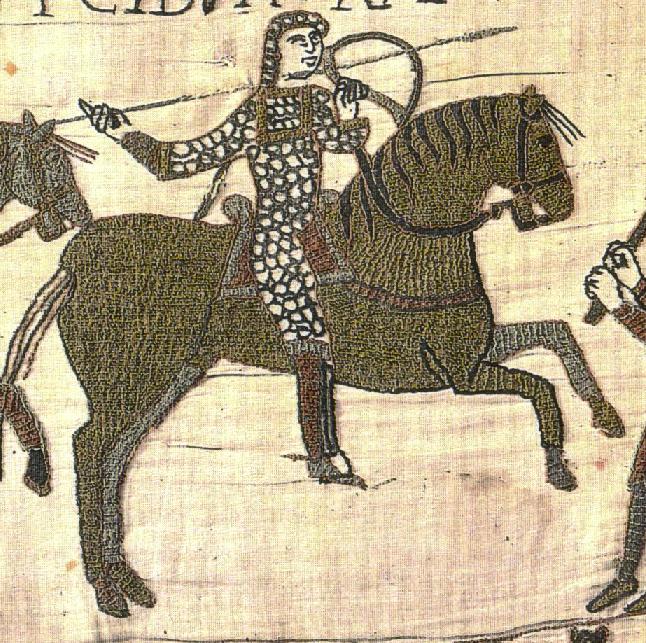
We know that coifs were
in use from scenes where warriors wear them without helmets, though of course
this does not constitute proof that aventails were not also used.
I have looked carefully at the Bayeux tapestry, and have found several pictures that are pretty definitely indicative of a separate coif.
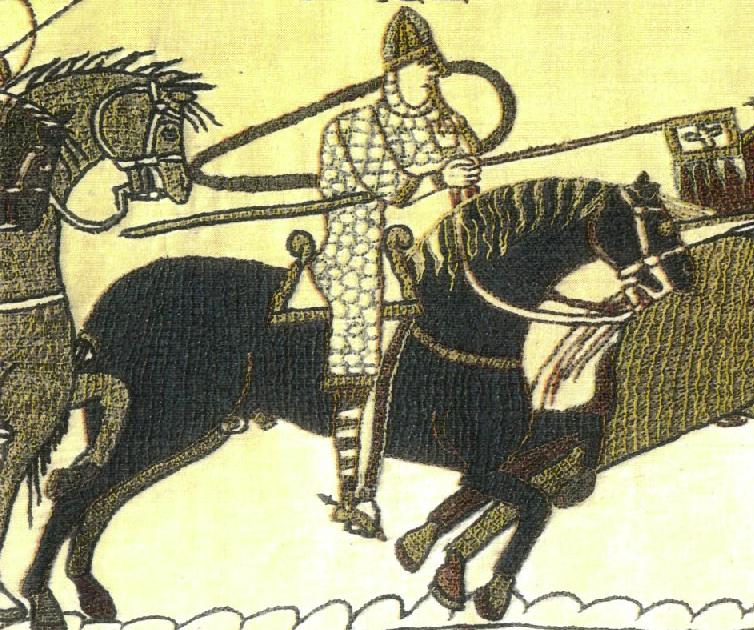
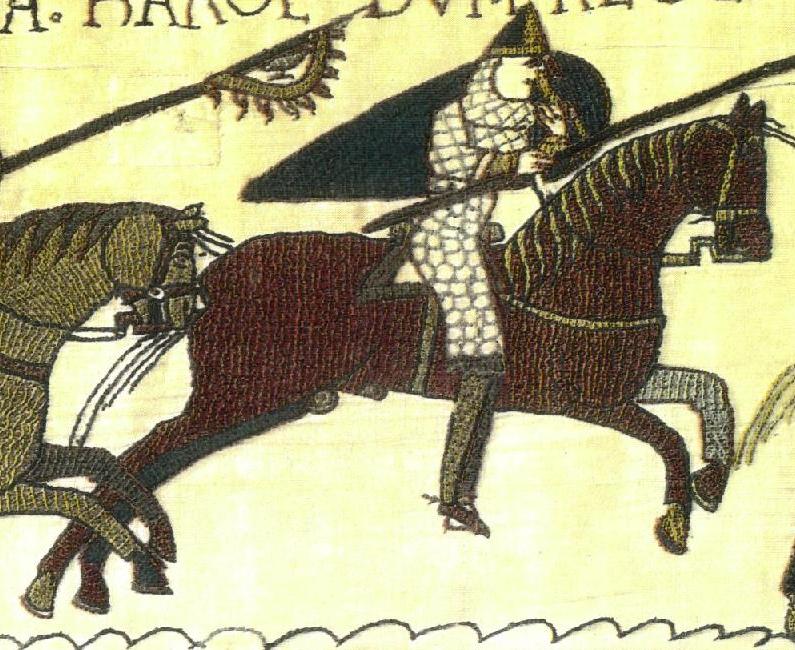
And several figures have coifs shown a different colour from the hauberk.
 As well as these, there are a
great many which are equivocal at best, with coifs that may or may not even be
of mail
(perhaps it is a different coloured border that obscures the sides of the coif?).
As well as these, there are a
great many which are equivocal at best, with coifs that may or may not even be
of mail
(perhaps it is a different coloured border that obscures the sides of the coif?). 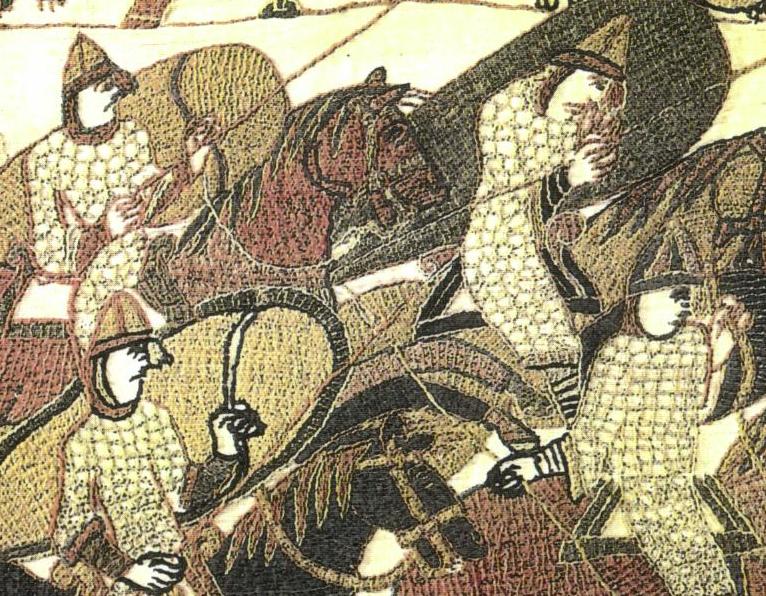
The hauberks that are being carried to the ships show no obvious sign of an integral coif, though as they're seen from in front, the coifs may be hidden, hanging behind the hauberk. And in fact the one on the right shows a row mail rings at the neck, just where you might expect to see part of the coif.
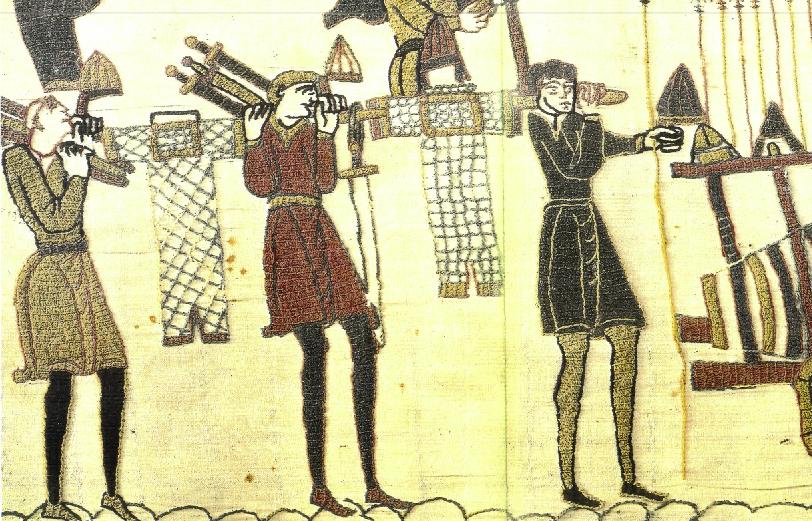 However, there are Norman knights in
hauberks, who are bareheaded, with again no sign of a coif hanging behind.
However, there are Norman knights in
hauberks, who are bareheaded, with again no sign of a coif hanging behind. 
If a person is wearing a
"bib" (ventail) as many of them do (see my article at
http://www.geocities.com/egfrothos/Bib1.html),
the line between the coif and hauberk would be obscured by the bib itself - a
separate coif would be open at the front, not reaching under the chin, and the
line of join would only be visible at the back. That the coif was open at the neck is confirmed by the figure
here,
and others elsewhere in the Tapestry.
Though the bodies shown
in the Tapestry being looted show no sign of a coif attached to the hauberk, an
integral coif probably wouldn’t be visible when the hauberk is being pulled off
– inside out - over the dead person’s head, so perhaps we should not take any
lessons from that, either way. An interesting detail which I had not noticed
before writing this article, is that these hauberks all seem to be fairly tight
at the neck, with what appears to be a fabric collar.
It also has to be stated
that a non-integral coif is not all THAT visible as a separate item, anyway.
Can you honestly say you can tell one from the other at any more than 10 feet?
(Though Michael Boughey disagrees - in his own words “At least as
constructed by many re-enactors, separate coifs stand out, possibly because of
the untidiness of their fit.”) However, many of the figures on the Tapestry
do show pretty unequivocal continuity between the hauberk and the coif.
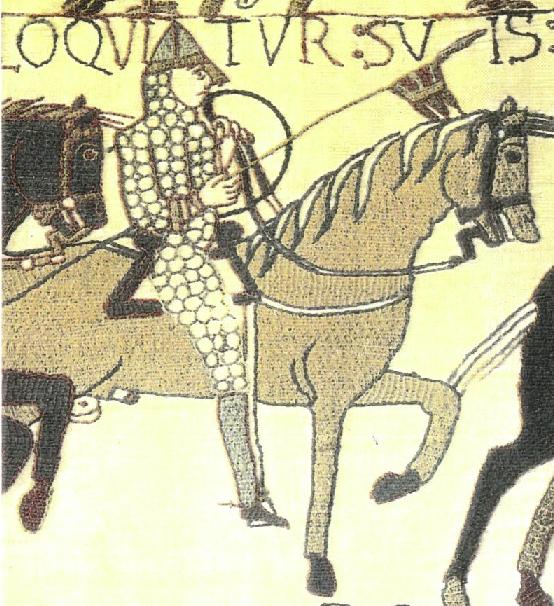

It is as
difficult to definitively document integral coifs as it is to document separate
ones. Most contemporary pictures which show armour between the hauberk and the
helmet are equivocal - they can be interpreted either way. However, the mail
shirts that have been found from this period don't appear to have had integral
coifs - the Wenceslaus hauberk in particular. I had been under the impression
that the one found at Gjermundbu was also without a coif, but Anders Helseth
has kindly pointed out that
“it was found in 85 pieces (Grieg 1947) and nothing of any certainty can be said about its function except that judging from the amount of mail it probably was a shirt.”
Given that there are so
few of these finds, this in itself means nothing. But if it is evidence for
anything, it's evidence for separate coifs.
In my opinion, the likely
evolution is: hauberk plus
1)
helmet
with aventail, then
2)
coif,
then
3)
integral
coif.
A coif provides more
complete neck protection than an aventail – if it’s properly made, there is
less chance of embarrassing gaps at the bottom to let a weapon in, because it
is bedded down on the shoulders, not hanging from a helmet. A separate coif is
somewhat easier to make than an integral one, and I think would have come first
- I haven't come across convincing evidence in anything I've read or seen so
far that integral coifs appeared like Venus, fully formed at birth. Even so, it
might be considerably easier to cut off a head when there was a gap between
coif and hauberk than otherwise, which is a possible explanation for the
development of the integral coif.
Of course I can't prove
this - it's based simply on my own reading of the evidence.
I am quite happy to
concede that integral coifs did exist, and that there are quite unequivocal
examples in carvings from the 13th century. Michael Boughey has pointed to
fairly strong evidence for them in Romanesque carvings from the 12th
century, as well. However, what I'm talking about is the 11th century,
particularly the battle of Hastings (but also the decades either side of it).
The question is whether integral coifs were already in use during the 11th
century, or not till later.
The evidence by no means
proves that all coifs were integral with the hauberk in our period, in either
the English OR the Norman armies. I'm happy to be proved wrong if someone can
make a convincing enough case. But I'm certainly not going to deny the evidence
of my eyes because other people, with no better information than I, say
something different.
I've been looking through
my collection of contemporary (10th & 11th century) pics, and both seem to
appear -there are slightly more pics of what look like integral coifs than ones
which appear to be separate coifs (or possibly aventails) - at least one has
both in the same scene.
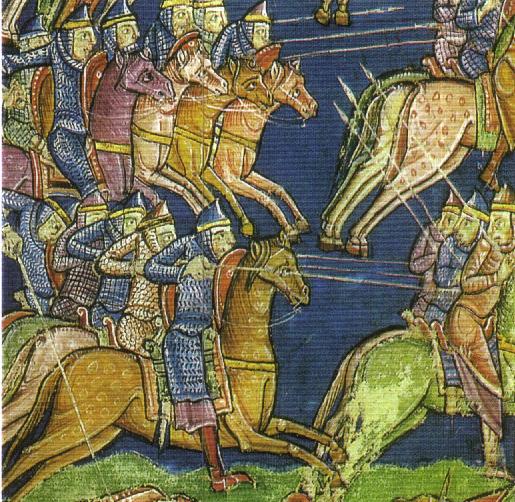
While researching all
this I came across another picture - this dates to between 1125 and 1150, and
is from the Pierpoint Morgan library, M. 736, folio 7v. (For a more detailed view, see here).
Note the demarcation at
the neck, particularly obvious on the guy at bottom left, but evident in
several of the others. It could be argued that it is the guige from the kite
shield, but I don't think that’s what it is - on the guy at the bottom left,
particularly, the line seems to indicate a separate coif, not a guige.
Well, there it is. From
the above, I don’t think there’s any doubt that separate coifs were in use as
early as 1100, and the pictures from the Bayeux Tapestry at least, support an
earlier date. But it seems that by the mid-late 12th century they
had disappeared in favour of the integral coif, not to reappear till several
centuries later.
For the Battle of
Hastings, I think we can be quite confident that both types appeared on the
field, and there are fair indications that other materials were also used to
protect the neck. Whether aventails were also in use is uncertain, but
certainly some contemporary pictures hint at it, and I can’t see why they
wouldn’t have been used as well.
With "Bib": 2
With "integral aventail": 25
INTEGRAL COIFS:With "Bib": 7
With "Integral Aventail": 43
"BIBS" WITHOUT VISIBLE COIF: 11
"BIBS WITH COIF - fitting of coif uncertain: 19
INTEGRAL COIF - no ventail: 2
As well as this there are a considerable number of coifs where it is impossible to see whether there is any indication of a "bib" or and "integral ventail". I've left these out of the count. Well, you never stop learning, do you? Fascinating stuff.
 Visitors to this page
Visitors to this page
| Text copyright ©
Steven Lowe 2003. The information on this page is for research and study purposes only.
stevenlo@bigpond.net.au |